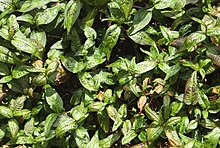Vietnamese mint
| Vietnamese coriander | |
|---|---|
 |
|
| Scientific classification | |
| Kingdom: | Plantae |
| (unranked): | Angiosperms |
| (unranked): | Eudicots |
| (unranked): | Core eudicots |
| Order: | Caryophyllales |
| Family: | Polygonaceae |
| Genus: | Persicaria |
| Species: | P. odorata |
| Binomial name | |
|
Persicaria odorata (Lour.) Soják 1974 |
|
| Synonyms | |
|
Polygonum odoratum Lour. 1790 |
|
Polygonum odoratum Lour. 1790
Persicaria odorata, the Vietnamese coriander, is an herb whose leaves are used in Southeast Asian cooking. Other English names for the herb include Vietnamese mint, Vietnamese cilantro, Cambodian mint, hot mint, laksa leaf, and praew leaf. Its Vietnamese name is rau răm, while in Indonesia, Malaysia, and Singapore it is called daun kesum, daun kesom, or daun laksa. In Thailand, it is called phak phai (ผักไผ่) and the Hmong word for it is luam laws. In Laos, it is called phak phaew (ຜັກແພວ), and in Cambodia chi krasang tomhom (ជីរក្រសាំងទំហំ) or chi pong tea koun (ជីរពងទាកូន). In North-East India, Manipur state uses this as garnishing herb over various cuisines such as Eromba and Singju. Meiteis called it as phak-phai.
It is neither related to the mints, nor is it in the mint family Lamiaceae but the general appearance and odor are reminiscent of them. Persicaria is in the family Polygonaceae, collectively known as smartweeds or pinkweeds.
Above all, the leaf is identified with Vietnamese cuisine, where it is commonly eaten fresh in salads (including chicken salad) and in raw gỏi cuốn, as well as in some soups such as canh chua and bún thang, and stews, such as fish kho tộ. It is also popularly eaten with hột vịt lộn (fertilized duck egg).
...
Wikipedia
